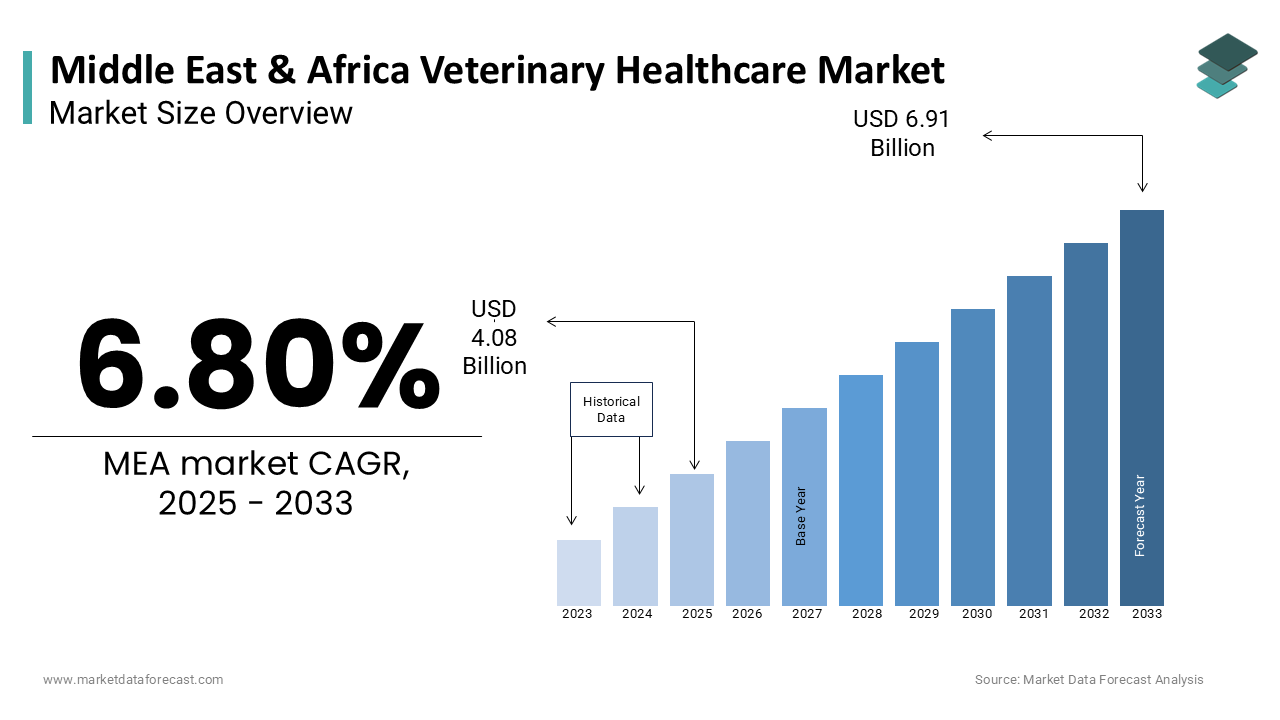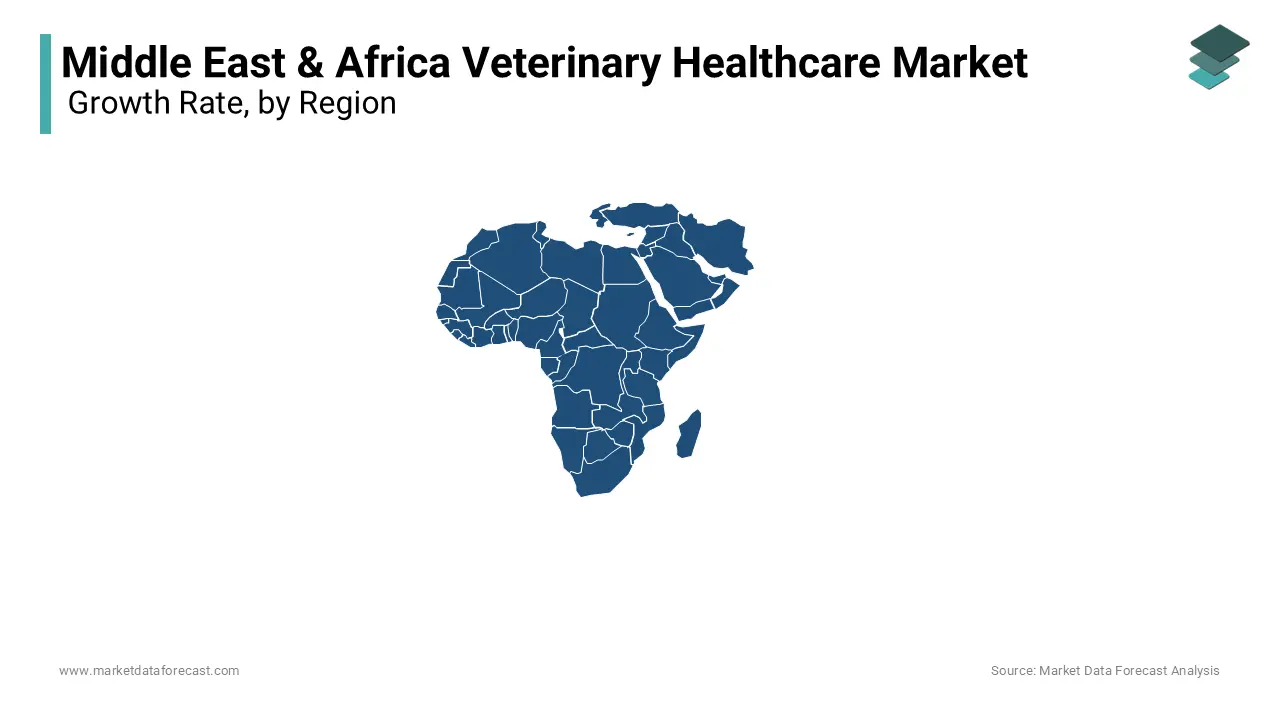Middle East & Africa Veterinary Healthcare Market Research Report By Animal Type (Livestock Animals, Companion Animals), Product and Country (KSA, UAE, Israel, rest of GCC countries, South Africa, Ethiopia, Kenya, Egypt, Sudan, rest of MEA), Industry Analysis from 2025 to 2033
Middle East & Africa Veterinary Healthcare Market Size
The size of the veterinary healthcare market in the Middle East & Africa veterinary healthcare market was worth USD 3.82 billion in 2024 The MEA market is estimated to grow at a tremendous CAGR of 6.8% from 2025 to 2033 and be worth USD 6.91 billion by 2033 from USD 4.08 billion in 2025.

Veterinary healthcare helps diagnose, treat, and prevent diseases in animals. Veterinary medicine covers various animal species, including domestic and wild. With the increased production of livestock animals, there is significant growth in the animal healthcare market. In addition, the stable economy and rising population, especially in developing countries, have increased the demand for protein-rich foods.
MARKET DRIVERS
Rising awareness among people regarding animal health, few restraints regarding drug approval for animal healthcare, and increasing love for pets are expected to drive the veterinary healthcare market. Increasing pet adoption and insurance policies for veterinary healthcare are propelling market growth in the Middle East and Africa. In addition, rising meat consumption, an increasing number of veterinary hospitals, and the growing production of livestock animals are further fuelling the growth rate of the veterinary healthcare market in the Middle East and Africa. The requirement for meat production is growing significantly in Middle East countries due to growing consumption. In addition, increasing dietary use is further favoring the veterinary healthcare market in the Middle East and Africa. In recent years, many people have shown interest in having dietary products such as milk, cheese, curd, and milk-based sweets in their daily diet, which helps bones strengthen and boost immunity. In Saudi Arabia, the mean production was 700,000 MT in 2019, which is expected to increase more in the coming years.
Increasing the number of foodborne diseases also fuels the healthcare market for animals. Zoonotic diseases are a significant threat to wildlife animals and also to humans. To reduce these types of diseases among animals,' the veterinary healthcare market has the highest demand. Initiatives called "One Health" were started in South Africa and helped the National Department of Health by organizing the surveillance of zoonotic diseases.
MARKET RESTRAINTS
However, the market's growth is restrained by the increasing antibiotics regulations and the rising cost of animal testing. High costs associated with animal services are the major restraint for market growth. Furthermore, lack of infrastructure, less awareness about veterinary healthcare, and lack of skilled professionals are other factors that restrain the market growth. In addition, less availability of different types of animal healthcare-related devices in this Middle East Africa region also hampers the market growth.
REGIONAL ANALYSIS

MEA and APAC regions hold around 80% of the sheep and goat population, according to the data published by the Food and Agricultural Organization of the United Nations in 2023. Therefore, the investments to keep pets' healthcare safe are growing at a healthy rate in this region and are predicted to reflect market growth during the forecast period. Currently, the Middle East and Africa hold only a small portion of the global market compared to the other regions. However, the conditions are expected to change soon with changing market conditions and the occupancy of MEA in the global market is expected to increase during the forecast period. South Africa is the second largest country in Middle East Africa. Increasing manufacturing of vaccines and drugs for animal diseases propels the market in South Africa. During COVID-19, the virus spread is also seen in animals, which increases the research on the medication and drugs for animals that help animals survive the infectious diseases that demand the veterinary healthcare market. The veterinary healthcare market in Saudi Arabia is expected to register a healthy CAGR during the forecast period owing to the increasing number of veterinary hospitals in Saudi Arabia. In addition, the government of Saudi Arabia improved the services to animals by using advanced devices to help them recover quickly from illness.
KEY MARKET PLAYERS
A few of the noteworthy companies in the MEA veterinary healthcare market profiled in this report are Merck & Co., Inc., Bayer AG, Boehringer Ingelheim GmbH, Cargill, Inc., Ceva Santé Animale, Novasep, Eli Lilly and Company, Koninklijke DSM N.V, Novartis AG, Nutreco N.V., Sanofi S.A., SeQuent Scientific Ltd., Virbac S.A., Vétoquinol S.A., and Zoetis Inc.
MARKET SEGMENTATION
This research report on the MEA veterinary healthcare market has been segmented and sub-segmented into the following categories.
By Animal Type
- Livestock Animals
- Companion Animals
By Product
- Pharmaceuticals
- Feed Additives
By Country
- KSA
- UAE
- Israel
- rest of GCC countries
- South Africa
- Ethiopia
- Kenya
- Egypt
- Sudan
- Rest of MEA
Related Reports
Access the study in MULTIPLE FORMATS
Purchase options starting from $ 1600
Didn’t find what you’re looking for?
TALK TO OUR ANALYST TEAM
Need something within your budget?
NO WORRIES! WE GOT YOU COVERED!
Call us on: +1 888 702 9696 (U.S Toll Free)
Write to us: [email protected]
